
Kaleb, also known as Elesbaan, was King of Aksum, which was situated in what is now Ethiopia and Eritrea.
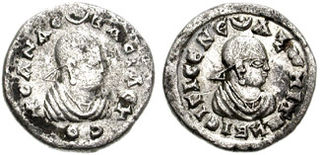
Ousanas was a King of Axum. Stuart Munro-Hay believes that it is "very likely" that Ousanas is the king to whom Aedesius and Frumentius were brought. In Eritrean and Ethiopian tradition, this king is called Ella Allada or Ella Amida. Ella Amida would then be his throne name, although Ousanas is the name that appears on his coins. If this identification is correct, then it was during his reign that Christianity was introduced to Axum and the surrounding territories.

Endubis or Endybis was a late-3rd-century sovereign of the Kingdom of Aksum in East Africa. He was among the earliest rulers in the Africa to mint his own coins; according to Stuart Munro-Hay, "No other sub-Saharan African state issued its own independent coinage in ancient times -- indeed no other African state at all, since those in North Africa fell under Roman dominion." The Aksumite currency of his reign was issued in gold, silver, and bronze or copper denominations and bore inscriptions in Koine Greek.

Aphilas beni Dimel was a King of the Kingdom of Aksum. He is known only from the coins he minted, which are characterized by a number of experiments in imagery on the obverse, and being issued in fractions of weight that none of his successors copied.

WZB, vocalized by historians as Wazeba, was a Negus of the Kingdom of Aksum, centered in the highlands of modern Ethiopia and Eritrea. He succeeded Aphilas. Wazeba is known only from the coins that he minted during his reign. He was the first Aksumite ruler to engrave the legends of his coins in Ge'ez, and the only King of Aksum to use that language on his gold currency. Stuart Munro-Hay suggests that the scarcity of Wazeba's coins may hint at a short reign.

MHDYS was a ruler of the Kingdom of Aksum. He is primarily known through the coins that were minted during his reign, although a contemporary poet, Nonnus of Panopolis, may have alluded to him in his epic Dionysiaca.

Eon was a King of the Kingdom of Aksum. He is primarily known through the coins minted during his reign, where his name is written in Greek as "Eon Bisi Anaaph". Only his coins issued in gold are known; many new examples were identified in the al-Madhariba hoard found in Yemen.
Alla Amidas was a king of the Kingdom of Aksum. He is primarily known from the coins minted during his reign.
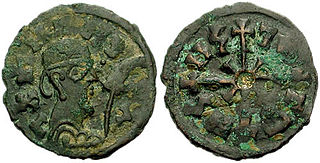
Wazena was a King of the Kingdom of Aksum. He is primarily known through the Aksumite currency that was minted during his reign. Without any clear discussion, Stuart Munro-Hay identifies him with a king Alla Amidas, who is also known only through the coins he issued.
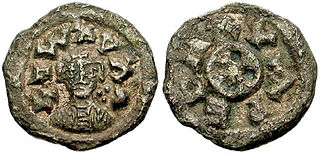
Ioel, or Joel, was a king of the Kingdom of Aksum. He is primarily known through the coins that were minted during his reign. He is one of several Aksumite kings with a Biblical name, the others include Israel, Kaleb, and likely Gersem and Noe; Ioel is named for the Biblical prophet, Joel, author of the Book of Joel.

Hataz was a king of the Kingdom of Aksum. He is primarily known through the coins that were minted during his reign, some of which call him Iathlia. His gold coin calls him Hethasas.
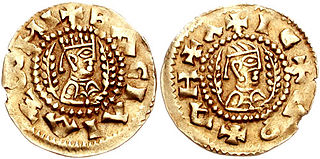
Israel was a king of Axum. He is primarily known through the coins minted during his reign. He is one of several Aksumite kings with a Biblical name, the others include Ioel, Kaleb, Gersem, and likely Noe; Richard Pankhurst mentions the name of this king as an early example of Judaic influence in Ethiopian culture.
Yemrehana Krestos was the third king of the Zagwe dynasty, ruling during the second half of the twelfth century. His biography is recorded in the Gädlä Yəmrəḥannä Krəstos.
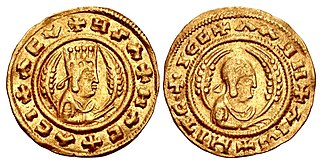
Aksumite currency was coinage produced and used within the Kingdom of Aksum centered in present-day Eritrea and Ethiopia. Its mintages were issued and circulated from the reign of King Endubis around AD 270 until it began its decline in the first half of the 7th century where they started using Dinar along with most parts of the Middle East. During the succeeding medieval period, Mogadishu currency, minted by the Sultanate of Mogadishu, was the most widely circulated currency in the eastern and southern parts of the Horn of Africa from the start of the 12th century.
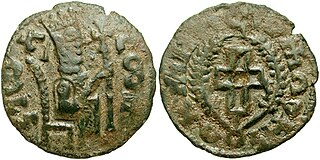
Armah was a king of the Aksum. He is primarily known through the coins that were minted during his reign. While some scholars have suggested as long ago as 1895 that he was identical to Najashi, the king of Axum who gave shelter to Muslim emigrants around 615-6, more recently Wolfgang Hahn has suggested Armah might have been the name of one of the sons of Kaleb, Alla Amidas.
Sofya (4th-century), was a queen consort and regent of the Kingdom of Axum.
Ethiopis or Itiyopp'is is the name of a legendary king from Ethiopian tradition who was the inspiration behind the name of the country, Ethiopia.
According to an Ethiopian tradition, the term Ethiopia is derived from the word Ethiopis, a name of the Ethiopian king, the seventh in the ancestral lines. Metshafe Aksum or the Ethiopian Book of Aksum identifies Itiopis as the twelfth king of Ethiopia and the father of Aksumawi. The Ethiopians pronounce Ethiopia እትዮጵያ with a Sades or the sixth sound እ as in incorporate and the graph ጰ has no equivalent in English or Latin graphs. Ethiopis is believed to be the twelfth direct descendant of Adam. His father is identified as Kush, while his grandfather is known as Kam.
Regnal lists of Ethiopia are recorded lists of monarchs who are claimed by tradition to have ruled Ethiopia. These lists are often recorded on manuscripts or orally by monasteries and have been passed down over the centuries.













